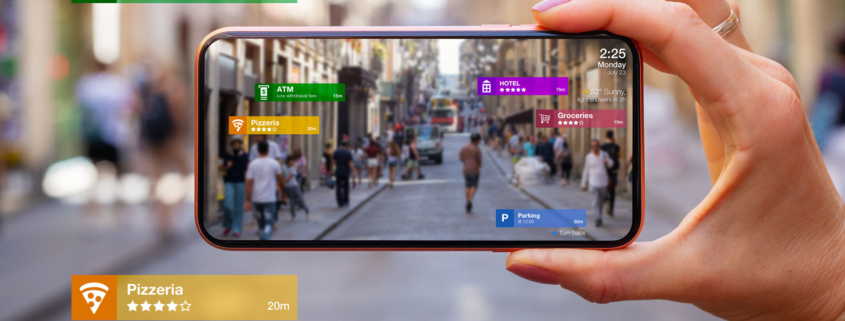Augmented Reality in Marketing: Breaking Brand Awareness Boundaries
Augmented reality (AR) seems like a new trend – but it’s actually been around since the late 60s. Recently, rapidly advancing and accessible technology has made it the new popular kid in school.
While some may say that it’s just an attention-grabbing gimmick, augmented reality could give quite a boost to your marketing campaigns. Provided you use it right, of course.
What Is Augmented Reality?
To put it simply, augmented reality is when technology is used to overlay digital information or graphics onto real-world environments in real time. Augmented reality technology makes use of mobile devices such as cellphones and tablets, as well as new technology like smart glasses. Keep in mind – there is a difference between AR and virtual reality; virtual reality is fully immersive and uses a headset to bring its users into the digital space.
Popular Augmented Reality Apps
You can’t talk about AR technology without talking about Pokémon Go. This AR application went viral in 2016 by providing an immersive experience where users could search out and catch wild Pokémon in real life. This AR app was extremely popular among users of all ages. Many believe it actually made the world a happier, friendlier place.
Social media is now full-to-bursting with augmented reality experiences. Snapchat and Instagram both have AR tech built into their apps that alter user’s real-world images. TikTok recently went viral for its AR aging filter.
Examples of Augmented Reality Marketing Campaigns
Of course, businesses have taken notice of the popularity and the possibilities that surround AR tech. Companies have jumped on the bandwagon, using AR campaigns to market their products to their target audience.
Some extra immersive and effective AR marketing campaigns include:
-
- Netflix promoted a new season of Stranger Things with an AR experience that let fans visit an in-person location to play games with AR tech.
- StubHub promoted NFL ticket sales with an AR 3D model of the stadium and surrounding area.
- Nike has done several successful AR campaigns, but one in particular that stands out is a mobile app where potential customers could point their phone at a print ad with a QR code – when they did, animated content about the products in the ad would appear.
- Pepsi wowed people in London by transforming a bus stop into an AR experience that made it seem like robots and flying saucers were attacking the city.
Benefits of AR Marketing
So why exactly are big brands jumping on the AR marketing train? Is it all just a trend? Well, no, not exactly. There are big benefits to incorporating AR into your digital marketing strategy. For instance – 71% of consumers say it would influence their purchase decisions positively. AR has many benefits that can help elevate your business to the next level.
Immersive Experiences Increase Brand Awareness
If you create branded AR content, it can give your social media marketing strategy a boost, as users are more likely to share AR content on their pages. This helps you reach new potential customers – especially if the content goes viral, as AR campaigns often do.
AR experiences designed to provide an entertaining, immersive experience increase customer engagement – which increases overall awareness of your brand. If you’re a B2C business that designs an in-store AR experience, you can draw the customers right to you.
Let Customers Try Products
AR has helped elevate ecommerce and in-store shopping alike by letting customers try out certain products before they buy them – helping reduce returns and increase customer satisfaction.
Virtual fitting rooms are on the rise when it comes to fashion brands. Sephora and L’Oreal both have AR apps that allow potential customers to see what products look like on them before they buy. Both the Ikea Place app and Amazon AR allow customers to see what furniture looks like in their homes before they purchase it.
Virtual try-ons like this help customers feel more sure in the decision-making process, improving the customer experience and curtailing any dissatisfaction – or the nasty surprise of a couch you fell in love with not quite fitting in your living room.
Educate Customers
AR allows you to easily educate your customers about your product. Videos are better than images at explaining how things work because they provide a more immersive experience where the customer gets to see the product in action.
AR is even more effective at showing how something works because it’s like the product is there with the customer. The more immersive the user experience is, the more they get a sense of what your product actually does – and why they need it.
The Future of Digital Marketing, Now
The key to a great marketing strategy is to stay on top of the trends, and the biggest viral trend right now is AR. What once seemed like pure science fiction is now digital marketing fact. While not everyone has the capability to produce AI content just yet, each day we’re moving closer to it being a standard experience.
At iSynergy, we’re excited about the possibilities of augmented reality in marketing. As digital marketing gurus, we’re committed to having our fingers on the pulse of marketing campaign trends – and evolving alongside them. If you’re interested in seeing how your brand can evolve as we do, contact us. We’ll help you push the boundaries of what is possible for your business.



